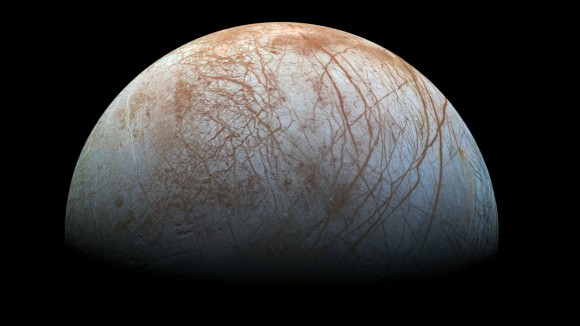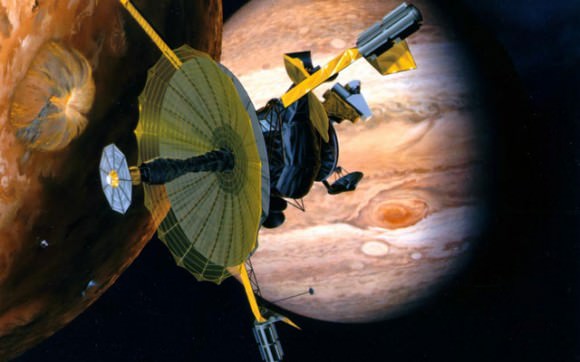Europa, Jupiter’s sixth-closest moon, has long been a source of fascination and wonder for astronomers. Not only is it unique amongst its Jovian peers for having a smooth, ice-covered surface, but it is believed that warm, ocean waters exist beneath that crust – which also makes it a strong candidate for extra-terrestrial life.
And now, combining a mosaic of color images with modern image processing techniques, NASA has produced a new version of what is perhaps the best view of Europa yet. And it is quite simply the closest approximation to what the human eye would see, and the next best thing to seeing it up close.
The high-resolution color image, which shows the largest portion of the moon’s surface, was made from images taken by NASA’s Galileo probe. Using the Solid-State Imaging (SSI) experiment, the craft captured these images during it’s first and fourteenth orbit through the Jupiter system, in 1995 and 1998 respectively.
The view was previously released as a mosaic with lower resolution and strongly enhanced color (as seen on the JPL’s website). To create this new version, the images were assembled into a realistic color view of the surface that approximates how Europa would appear to the human eye.

As shown above, the new image shows the stunning diversity of Europa’s surface geology. Long, linear cracks and ridges crisscross the surface, interrupted by regions of disrupted terrain where the surface ice crust has been broken up and re-frozen into new patterns.
Images taken through near-infrared, green, and violet filters have been combined to produce this view. The images have been corrected for light scattered outside of the image to provide a color correction that is calibrated by wavelength. Gaps in the images have been filled with simulated color based on the color of nearby surface areas with similar terrain types.
These color variations across the surface are associated with differences in geologic feature type and location. For example, areas that appear blue or white contain relatively pure water ice, while reddish and brownish areas include non-ice components in higher concentrations.
The polar regions, visible at the left and right of this view, are noticeably bluer than the more equatorial latitudes, which look more white. This color variation is thought to be due to differences in ice grain size in the two locations.

Credit: NASA
This view of Europa stands out as the color view that shows the largest portion of the moon’s surface at the highest resolution. An earlier, lower-resolution version of the view, published in 2001, featured colors that had been strongly enhanced. Space imaging enthusiasts have produced their own versions of the view using the publicly available data, but NASA has not previously issued its own rendition using near-natural color.
The image also features many long, curving, and linear fractures in the moon’s bright ice shell. Scientists are eager to learn if the reddish-brown fractures, and other markings spattered across the surface, contain clues about the geological history of Europa and the chemistry of the global ocean that is thought to exist beneath the ice.
This is of particular interest to scientists since this supposed ocean is the most promising place in our Solar System, beyond Earth, to look for present-day environments that are suitable for life. The Galileo mission found strong evidence that a subsurface ocean of salty water is in contact with a rocky seafloor. The cycling of material between the ocean and ice shell could potentially provide sources of chemical energy that could sustain simple life forms.
Future missions to Europa, which could involve anything from landers to space penetrators, may finally answer the question of whether or not life exists beyond our small, blue planet. Picturing this world in all of its icy glory is another small step along that path.
In addition to the newly processed image, JPL has released a new video that explains why this likely ocean world is a high priority for future exploration:
Further Reading: NASA

